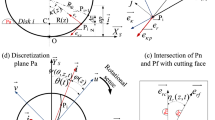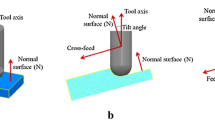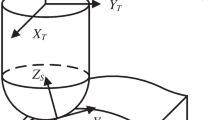Abstract
Ball-end cutters are widely used in industries of dies, molds, and aerospace, which have the problem of poor machined surface quality due to the low cutting speed near the tool-tip. With the increase in the complexity of parts, it will become more and more difficult to avoid the tool-tip participating in the cutting. In this paper, the velocity effect sensitivity of the ball-end cutter is analyzed, and several key positions, including the intersection points of the CWE boundaries, are selected to describe the cutting speed in three dimensions. The relationships between the cutting speed of the critical points and important variables such as the machining inclination angle and the feed direction were investigated. The optimal range of feed direction is obtained when the tool-tip engages in the contact circle. The core aim of the feed direction selection is to make the tool engagement area in a high position by changing the feed direction, to avoid surface damage and improve the quality of the machined surface. Finally, an experimental study was carried out, and the results corroborate the effectiveness of the selection method. In the experiment, it was also found that cutting-out from the cutter contact position can improve the surface quality in the directions of non-optimal range, and the milling force and chips shape will vary with the change of the feed direction.






















Similar content being viewed by others
Data availability
The datasets used or analyzed during the current study are available from the corresponding author on reasonable request.
Code availability
Not applicable.
Abbreviations
- OXYZ :
-
tool coordinate system
- O w X w Y w Z w :
-
processing coordinate system
- PX c Y c Z c :
-
tool contact coordinate system
- f :
-
tool feed direction
- N :
-
down and up milling coefficient
- s :
-
toolpath stepover
- R :
-
tool radius
- e :
-
cutting depth
- κ :
-
axial position angle
- θ :
-
radial position angle
- θ s :
-
phase difference
- β :
-
feed direction angle
- α p :
-
machined inclination angle
- λ :
-
horizontal rotation angle
- Di :
-
reference point on CWE
- Z i :
-
the Z coordinate at any reference point
- [T Z], [T X]:
-
rotation matrices around Z and X
- V f :
-
feed rate
- V c :
-
cutting speed
- φ, φ` :
-
speed proportional dimensionless number and it’s first derivative
- n :
-
spindle speed
- z n :
-
tooth number
- f z :
-
feed per tooth
- CWE:
-
Cutter Workpiece Engagement
- P:
-
Cutter contact point
- A, B, C:
-
Intersection points of CWE boundaries
- D, D`:
-
Intersection points between CWE boundaries and the inner circle
References
Geng L, Liu PL, Liu K (2015) Optimization of cutter posture based on cutting force prediction for five-axis machining with ball-end cutters. Int J Adv Manuf Technol 78(5–8):1289–1303. https://doi.org/10.1007/s00170-014-6719-1
Souza AF, Berkenbrock E, Diniz AE, Rodrigues AR (2015) Influences of the tool path strategy on the machining force when milling free form geometries with a ball-end cutting tool. J Brazilian Soc Mech Sci Eng 37(2):675–687. https://doi.org/10.1007/s40430-014-0200-9
Souza AF, Diniz AE, Rodrigues AR, Coelho RT (2014) Investigating the cutting phenomena in free-form milling using a ball-end cutting tool for die and mold manufacturing. Int J Adv Manuf Technol 71(9–12):1565–1577. https://doi.org/10.1007/s00170-013-5579-4
Luo M, Luo H, Zhang DH, Tang K (2018) Improving tool life in multi-axis milling of Ni-based superalloy with ball-end cutter based on the active cutting edge shift strategy. J Mater Process Technol 252:105–115. https://doi.org/10.1016/j.jmatprotec.2017.09.010
Molnar TG, Berezvai S, Kiss AK, Bachrathy D, Stepan G (2019) Experimental investigation of dynamic chip formation in orthogonal cutting. Int J Mach Tools Manuf 145:103429. https://doi.org/10.1016/j.ijmachtools.2019.103429
Ning L, Veldhuis SC, Yamamoto K (2008) Investigation of wear behavior and chip formation for cutting tools with nano-multilayered TiAlCrN/NbN PVD coating. Int J Mach Tools Manuf 48(6):656–665. https://doi.org/10.1016/j.ijmachtools.2007.10.021
Rowe WB, Bell WF, Brough D, Davies BJ (1986) Optimization studies in high removal rate centreless grinding. CIRP Ann - Manuf Technol 35:235–238. https://doi.org/10.1016/S0007-8506(07)61878-2
Tian L, Fu Y, Yang L, Xu J, Li H, Ding W (2013) Investigations of the “speed effect” on critical thickness of chip formation and grinding force in high speed and ultra-high speed grinding of superalloy. Jixie Gongcheng Xuebao (in Chinese)/journal Mech Eng 49, 169–177. https://doi.org/10.3901/JME.2013.09.169
Liu XL, Ma J, Yue CX, Wan Q (2017) Determining the minimum cutting thickness (MCT) of hardened steel based on ball end milling method. Jixie Gongcheng Xuebao (in Chinese)/Journal Mech Eng 53(1):180–189. https://doi.org/10.3901/JME.2017.01.180
Lee CM, Kim SW, Lee YH, Lee DW (2004) The optimal cutter orientation in ball end milling of cantilever-shaped thin plate. J Mater Process Technol 153-154(22):900–906. https://doi.org/10.1016/j.jmatprotec.2004.04.106
Daymi A, Boujelbene M, Linares JM, Bayraktar E, Ben Amara A (2009) Influence of workpiece inclination angle on the surface roughness in ball end milling of the titanium alloy Ti-6Al-4V. Journal of Achievements in Materials and Manufacturing Engineering 35(1):79–86. https://doi.org/10.2307/20788690
Kalvoda T, Hwang YR (2009) Impact of various ball cutter tool positions on the surface integrity of low carbon steel. J Mater Des 30(9):3360–3366. https://doi.org/10.1016/j.matdes.2009.03.039
Yao CF, Wu DX, Jin QC, Huang XC, Ren JX, Zhang DH (2013) Influence of high-speed milling parameter on 3D surface topography and fatigue behavior of TB6 titanium alloy. J Trans Nonferrous Met Soc China (English Ed) 23(3):650–660. https://doi.org/10.1016/S1003-6326(13)62512-1
Shen X, Zhang D, Tan L (2020) Effects of cutter path orientations on milling force, temperature, and surface integrity when ball end milling of TC17 alloy. J Proc Inst Mech Eng Part B J Eng Manuf 2020(7):1–13. https://doi.org/10.1177/0954405420971070
Nicola GL, Missell FP, Zeilmann RP (2010) Surface quality in milling of hardened H13 steel. Int J Adv Manuf Technol 49(1–4):53–62. https://doi.org/10.1007/s00170-009-2382-3
Aspinwall D K, Dewes R.C, Ng E.G, Sage C, Soo S.L (2007) The influence of cutter orientation and workpiece angle on machinability when high-speed milling Inconel 718 under finishing conditions. Int J Mach Tools Manuf 47(12–13):1839–1846. https://doi.org/10.1016/j.ijmachtools.2007.04.007
Tan L, Yao C, Ren J, Zhang D (2017) Effect of cutter path orientations on cutting forces, tool wear, and surface integrity when ball end milling TC17. Int J Adv Manuf Technol 88(9–12):2589–2602. https://doi.org/10.1007/s00170-016-8948-y
Toh CK (2005) Comparison of chip surface temperature between up and down milling orientations in high speed rough milling of hardened steel. J Mater Process Technol 167(1):110–118. https://doi.org/10.1016/j.jmatprotec.2004.10.004
Toh CK (2004) Surface topography analysis in high speed finish milling inclined hardened steel. J Precis Eng 28(4):386–398. https://doi.org/10.1016/j.precisioneng.2004.01.001
Chen XX, Zhao J, Zhang WW (2019) Optimization analysis considering the cutting effects for high-speed five-axis down milling process by employing ball end mill. Int J Adv Manuf Technol 105(1):5–8. https://doi.org/10.1007/s00170-019-04436-0
Zhang A S, Liu X L, Yue C X, Yang S C, Xia W (2020) Analysis of minimum cutting speed in velocity effect sensitive area of ball end mill. Jixie Gongcheng Xuebao (in Chinese) /journal Mech Eng 56(11):229 https://doi.org/10.3901/JME.2020.11.229
Kim GM, Cho PJ, Chu CN (2000) Cutting force prediction of sculptured surface ball-end milling using z-map. Int J Mach Tools Manuf 40(2):277–291. https://doi.org/10.1016/S0890-6955(99)00040-1
Lazoglu I (2003) Sculpture surface machining: a generalized model of ball-end milling force system. Int J Mach Tools Manuf 43(5):453–462. https://doi.org/10.1016/S0890-6955(02)00302-4
Imani BM, Sadeghi MH, Elbestawi MA (1998) An improved process simulation system for ball-end milling of sculptured surfaces. Int J Mach Tools Manuf 38(9):1089–1107. https://doi.org/10.1016/S0890-6955(97)00074-6
Wei ZC, Wang MJ, Zhu JN (2011) Cutting force prediction in ball end milling of sculptured surface with Z-level contouring tool path. Int J Mach Tools Manuf 51(5):428–432. https://doi.org/10.1016/j.ijmachtools.2011.01.011
Wei ZC, Wang MJ, Wang XW, Zhao DY (2017) A semi-analytical cutter workpiece engagement model for ball end milling of sculptured surface. Jixie Gongcheng Xuebao (in Chinese) /Journal Mech Eng 53(1):198–205. https://doi.org/10.3901/JME.2017.01.198
Habibi M, Kilic ZM, Altintas Y (2021) Minimizing flute engagement to adjust tool orientation for reducing surface errors in five-axis ball end milling operations. J Manuf Sci Eng 143(2):1–35. https://doi.org/10.1115/1.4048267
Funding
This research was funded by Projects of the International Cooperation and Exchanges for National Science Foundation of China (Grant Number 51720105009) and the National Key Research and Development Project of China (Grant Number 2019YFB1704800).
Author information
Authors and Affiliations
Contributions
Anshan Zhang: conceptualization, methodology, software, writing — original draft preparation. Xian-Li Liu: funding acquisition, project administration, writing — review and editing. Cai-Xu Yue: data curation, resources, writing — review and editing. Rong-Yi Li: data curation, investigation, visualization. Steven Y. Liang: writing — review and editing. Lihui Wang: writing — review and editing.
Corresponding author
Ethics declarations
Ethics approval
The content studied in this article belongs to the field of metal processing and does not involve humans and animals. This article strictly follows the accepted principles of ethical and professional conduct.
Consent to participate
My co-authors and I would like to opt in to In Review.
Consent for publication
I agree with the Copyright Transfer Statement.
Conflict of interest
The authors declare no competing interests.
Additional information
Publisher’s note
Springer Nature remains neutral with regard to jurisdictional claims in published maps and institutional affiliations.
Rights and permissions
About this article
Cite this article
Zhang, A., Liu, X., Yue, C. et al. Velocity effect sensitivity analysis of ball-end milling Ti-6Al-4 V. Int J Adv Manuf Technol 118, 3963–3982 (2022). https://doi.org/10.1007/s00170-021-08049-4
Received:
Accepted:
Published:
Issue Date:
DOI: https://doi.org/10.1007/s00170-021-08049-4




